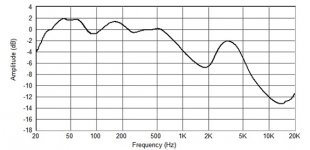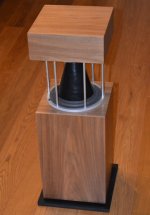I built copy of Lincoln Walsh Driver.
I used magnetic system from Tonsil GDN30/60 driver with 110mm magnet and 40mm voice coil.
I use two cone: first I use fiber glass but cone was to heavy (mms = 50g).
Second cone was made with paper and result is more better.
I use home made basket with 10mm aluminum cutting waterJet technology and six 6mm screw.
It was a lot of work but the effect is not perfect: The cone breaking in 2kHz.
The sound is quite good if I use equalizer and frequency is more linear.
---------------------------------
JS
Diyaudio.org - strona dla pasjonatów audio
I used magnetic system from Tonsil GDN30/60 driver with 110mm magnet and 40mm voice coil.
I use two cone: first I use fiber glass but cone was to heavy (mms = 50g).
Second cone was made with paper and result is more better.
I use home made basket with 10mm aluminum cutting waterJet technology and six 6mm screw.
It was a lot of work but the effect is not perfect: The cone breaking in 2kHz.
The sound is quite good if I use equalizer and frequency is more linear.
---------------------------------
JS
Diyaudio.org - strona dla pasjonatów audio
Attachments
Well the execution is a bit odd. Paper does not seem like a good option the idea is to have the highest stiffness to density ratio. The material really needs to be considered as well as the dimension/geometric shape. The Termination point seems odd. Could you expand on your design and execution a little? Sorry if this comes across a little strong but I am just curious as to the design you chose.
Last edited:
You could put a little cylinder of lighter material (e.g. hard foam or balsa, max. 4 mm wall) between voice coil and cone. Paper can be damped very well with hardwax oil (2 applications, drying time is endless). Japanese washi paper is better damped than industrial paper. No idea whether it is available in the right format/weight, however.
P.S. are you sure the voice coil inductance is low enough to do the Job? I see good chances only for voice coils of compression drivers. Would mean very low xmax, however.
P.S. are you sure the voice coil inductance is low enough to do the Job? I see good chances only for voice coils of compression drivers. Would mean very low xmax, however.
Last edited:
P.S. are you sure the voice coil inductance is low enough to do the Job? I see good chances only for voice coils of compression drivers. Would mean very low xmax, however.
Excellent point!
Also walsh drivers normally transistion from a thin metal near the VC and dampen further out with other materials. The transistion is best made with a deeply serrated edge adhered near the edge (slight overlap). Bending wave speaker drivers use different properties of wave propagation to function, very different than normally used
- Status
- Not open for further replies.

